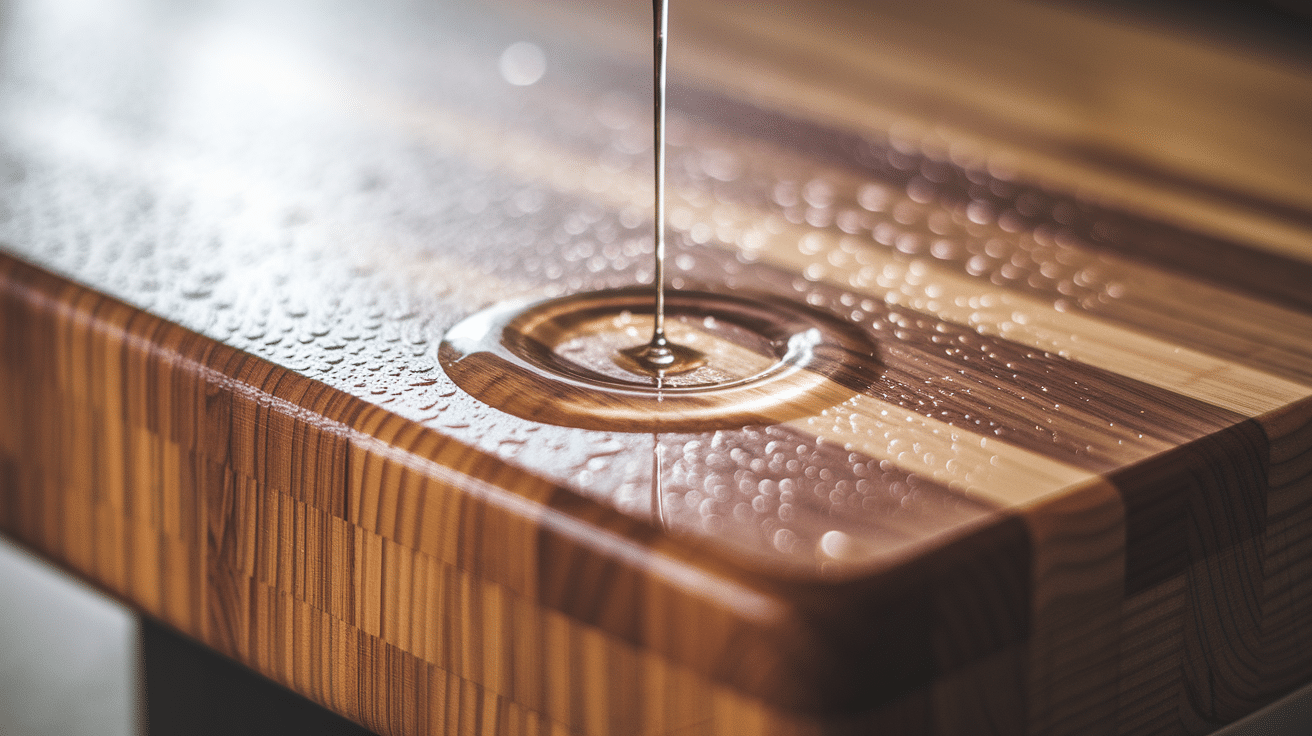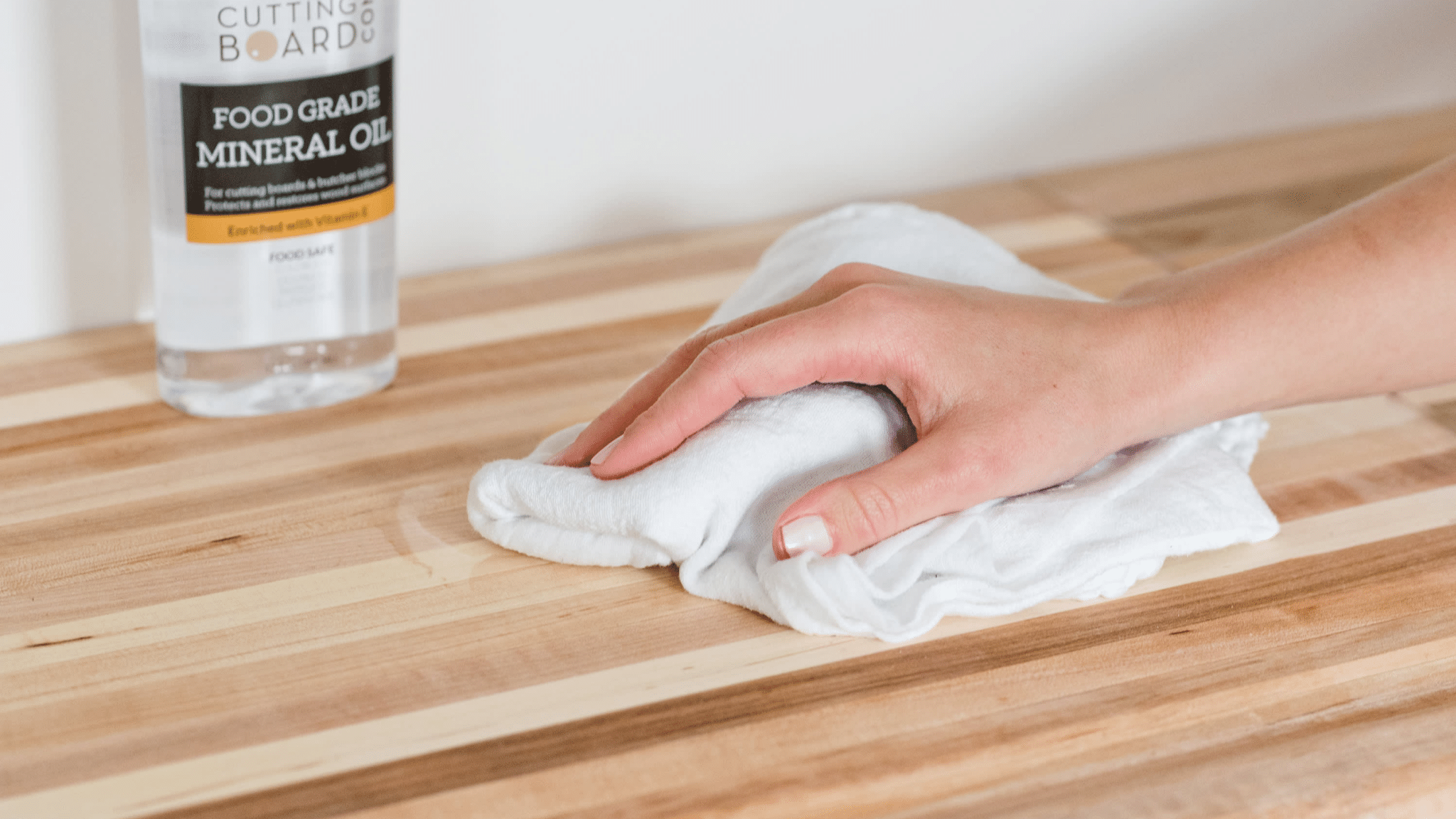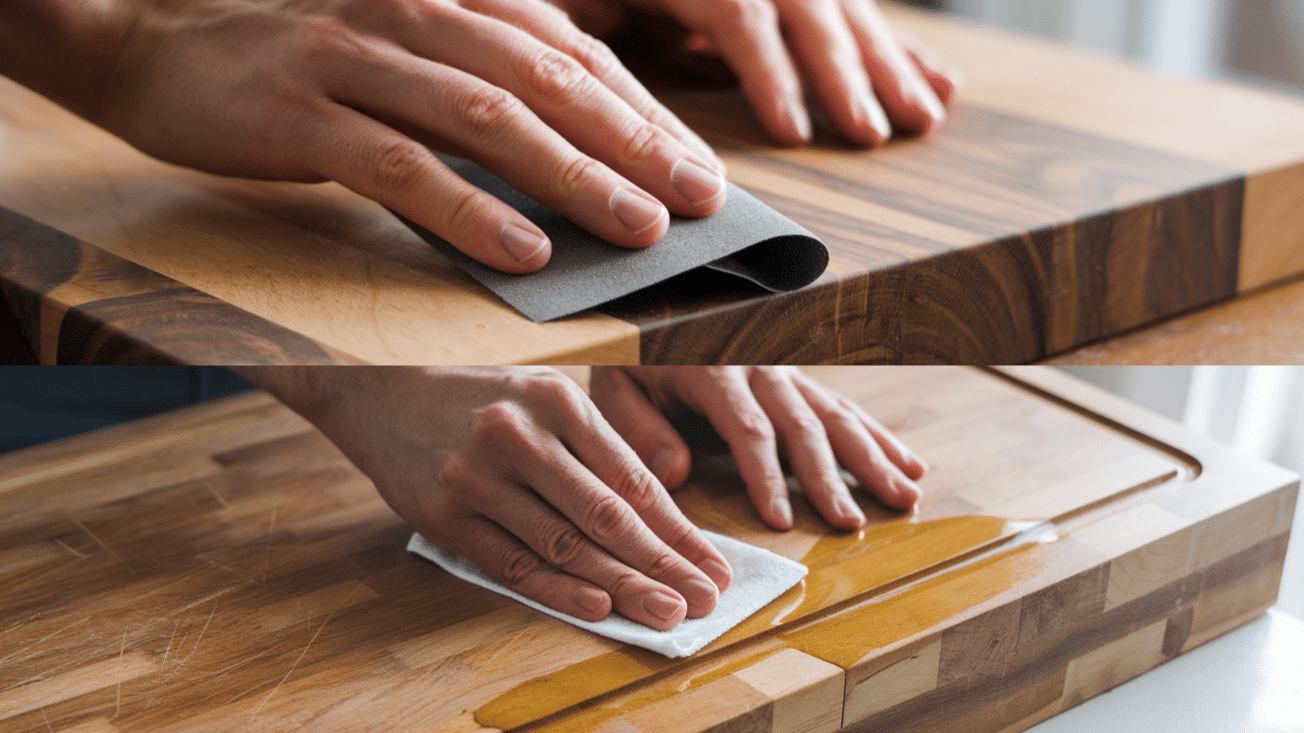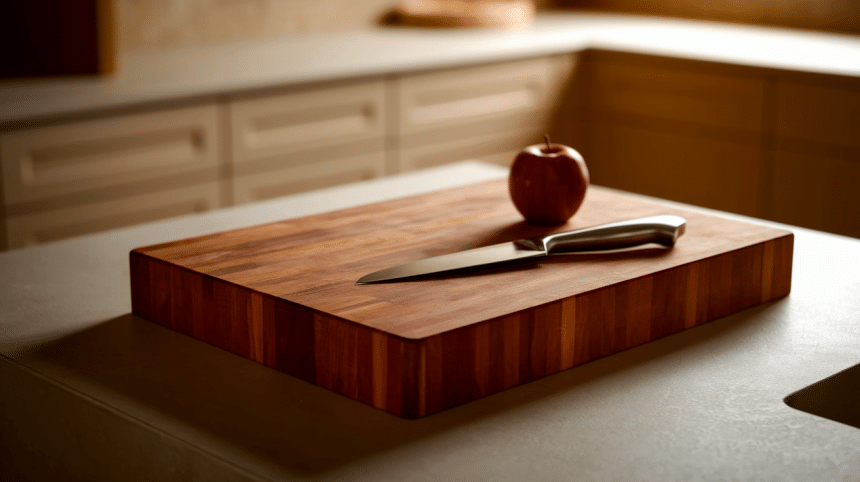Ever noticed how a beautiful butcher block starts to look a bit sad after a water spill? You’re not alone.
Many home cooks have watched their once-pristine cutting boards slowly change after countless meal preps and forgotten wipe-downs.
Water is sneaky that way. It seems harmless, but it’s actually a butcher block’s worst enemy. Those tiny droplets work their way into the wood, causing warping, staining, and even mold in particularly unlucky cases.
This guide walks through some simple ways to protect this kitchen investment from water damage, extending its life for years to come.
Because let’s face it – a good butcher block isn’t cheap, and keeping it beautiful is worth the effort.
What is a Butcher Block?
A butcher block is a solid, thick wooden surface originally designed for butchers to chop and prepare meat.
These durable work surfaces are made by bonding together strips of hardwood—typically maple, walnut, oak, cherry, or beech—to create a sturdy and resilient cutting platform.
The tradition of butcher blocks dates back centuries, when professional butchers needed a surface that could withstand the constant chopping, cleaving, and cutting involved in meat preparation.
Unlike ordinary wooden boards, authentic butcher blocks feature dense hardwoods specifically chosen for their durability, tight grain patterns, and resistance to bacteria.
Is Butcher Block Naturally Waterproof?

Butcher block countertops, made from natural wood, are not inherently waterproof.
Wood absorbs moisture, which can lead to warping, staining, and potential damage over time.
While butcher block can resist some moisture, prolonged exposure to water without proper protection can affect its durability.
To enhance its water resistance, butcher block surfaces need to be sealed and regularly maintained with oils, waxes, or polyurethane coatings, creating a protective barrier against water and moisture.
Without these treatments, butcher block is susceptible to the damaging effects of water.
How to Make Butcher Block Water-Resistant?

To protect butcher block countertops from water damage, you can apply various water-resistant treatments.
These treatments help seal the wood and create a barrier that prevents moisture from penetrating the surface.
The most common treatments include mineral oil, beeswax, and polyurethane. Each has its own benefits and drawbacks, so it’s important to choose the one that best suits your needs.
Mineral Oil
How it works: Mineral oil penetrates the wood and provides moisture protection by soaking into the fibers, helping to prevent cracking and drying out.
- Pros: Easy to apply, food-safe, and inexpensive. It maintains the natural look and feel of the wood.
- Cons: Needs to be reapplied regularly (every few weeks to months) and may not provide a long-lasting barrier against water.
Beeswax
How it works: Beeswax is a natural wax that sits on top of the wood, providing a protective layer against moisture.
- Pros: It adds a rich, smooth finish, enhances the wood’s natural color, and is also food-safe.
- Cons: It doesn’t penetrate as deeply as mineral oil, so it may require more frequent reapplication. It may also leave a slightly waxy surface that could attract dust and grime.
Polyurethane
How it works: Polyurethane is a synthetic coating that forms a hard, water-resistant layer on the surface of the wood, sealing it completely.
- Pros: Provides long-lasting protection, is easy to clean, and requires fewer applications compared to oils or waxes.
- Cons: It may alter the wood’s natural appearance, giving it a glossy finish. It can also be challenging to reapply without sanding the surface first.
The choice between these treatments depends on your desired aesthetic and the level of maintenance you’re willing to perform.
How to Seal Butcher Blocks: Step-by-Step Guide

1 Clean and Sand the Surface: Wipe down the butcher block to remove any debris and then sand the surface with fine-grit sandpaper (220-grit) to smooth out any imperfections.
2 Choose and Apply a Sealer: Select a food-safe sealer, like mineral oil or beeswax, and apply it evenly to the surface using a clean cloth or sponge, working in small sections.
3 Let the Sealer Soak In: Allow the sealer to soak into the wood for 15 to 30 minutes. Then, wipe off any excess with a clean cloth to prevent a sticky residue.
4 Let It Cure: Let the butcher block cure for 24 to 48 hours to ensure the sealer fully bonds and creates a durable protective layer.
5 Reapply as Needed: For extra protection, apply additional coats of sealer after the first one has dried, repeating the soaking and buffing process as needed.
Care Tips to Protect Your Butcher Block
- Clean Immediately After Use: Wipe down the surface with a damp cloth after each use to prevent food particles and moisture from soaking into the wood.
- Use Cutting Boards: Always use a cutting board when chopping or slicing to prevent deep cuts and scratches on the butcher block surface.
-
Avoid Excessive Moisture: Do not let water or other liquids sit on the surface for long periods. Wipe up spills right away to prevent water damage.
-
Reseat Regularly: Apply a food-safe oil or wax to your butcher block every few weeks to keep the wood nourished and resistant to moisture.
- Use Coasters for Hot Items: Avoid placing hot pots or pans directly on the butcher block. Use trivets or hot pads to protect the wood from heat damage.
- Prevent Stains: Clean up stains immediately, especially from acidic foods like wine, citrus, or vinegar, as they can discolor the wood.
- Don’t Expose to Direct Sunlight: Keep the butcher block out of direct sunlight for extended periods, as UV rays can cause fading or warping over time.
- Refinish as Needed: Periodically sand and refinish the surface if it becomes worn or scratched, to restore its smoothness and protect the wood.
Refinish as Needed: Periodically sand and refinish the surface if it becomes worn or scratched, to restore its smoothness and protect the wood.
Keeping Your Butcher Block Safe and Beautiful
A well-maintained butcher block becomes more than just a kitchen surface—it becomes part of your home’s character. Water damage doesn’t have to be inevitable.
With consistent care through regular oiling, prompt cleanup of spills, and strategic placement away from splash zones, your butcher block can maintain its warmth and functionality for decades.
The small habits you develop today—wiping down after use, applying mineral oil seasonally, addressing minor water spots quickly—all add up to significant protection.
Remember: a few minutes of preventative care saves hours of restoration work. Your butcher block is worth the effort.
Frequently Asked Questions
Can You Permanently Seal Butcher Block Countertops?
Yes, butcher block countertops can be permanently sealed using polyurethane, conversion varnish, or epoxy.
How Often Should I Oil a Butcher Block Countertop?
Unsealed or oil-finished butcher blocks need regular maintenance. For heavy-use areas, apply food-grade mineral oil every 1-3 months or monthly.
Do Butcher Block Countertops Get Water Stains?
Butcher blocks, especially untreated ones, are susceptible to water stains. Even sealed blocks can stain if water sits too long on damaged areas.

